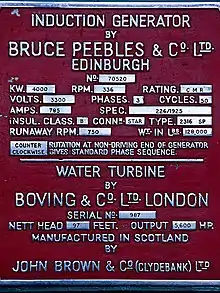Rating plate
A rating plate on a machine carries information about its operational limits. The plate frequently contains the names of the machine and its manufacturer, so the rating plate is often called a name plate (hence the term "nameplate capacity" for a generator), although many devices carry separate nameplates and rating plates.[1]

For an electric machine, the power rating is the number on its rating plate and corresponds to a maximum electric load it can carry. There is a distinction between the continuous rating (for generators, continuous maximum rating or CMR[2]), at which the machine can be operational without a time limit and short-term rating that can only be used for a specified amount of time.[3]
Generators
A typical electrical generator rating plate contains the following parameters:[4]
- power rating is specified in terms of apparent power (KVA or MVA), since the exact power factor will be determined by the external factors;[5]
- power factor (PF) is the nominal power factor for other ratings; usually PF = 0.8;[5]
- insulation class (B, F, H) for the primary coil. Typical value is F, although older generators might use class B;[5]
- type of enclosure (IP code);[6]
- rated voltage can be either line to line ("line voltage") or phase to neutral ("phase voltage");[6]
- rated current is derived from the rated power and voltage: ;[6]
- line frequency (50 Hz or 60 Hz) and rotational speed of the prime mover in RPM;[6]
- connection (star or delta).
See also
References
- National Electric Light Association (1924). "Rating Plate". Handbook for Electrical Metermen. Nineteenth Century Collections Online (NCCO): Science, Technology, and Medicine: 1780-1925. Franklin printing Company. p. 1185. Retrieved 2023-07-15.
- Stuart, S. (2013). "The Rating of Generators". Electrical (Generator and Electrical Plant): Modern Power Station Practice. Elsevier Science. p. 18. ISBN 978-1-4831-5751-1. Retrieved 2023-07-15.
- British Standards Institution (1917). "Definitions". British Standardisation Rules for Electrical Machinery (excluding Motors of Traction Purposes) Rev. September, 1917. British Standardisation Rules for Electrical Machinery (excluding Motors of Traction Purposes) Rev. September, 1917. committee. p. 18. Retrieved 2023-07-15.
- Reddy 2021, pp. 81–84.
- Reddy 2021, p. 81.
- Reddy 2021, p. 83.
Sources
- Reddy, B.K. (2021). "Rating Plates". Electrical Equipment: A Field Guide. Wiley. ISBN 978-1-119-77168-5. Retrieved 2023-10-14.